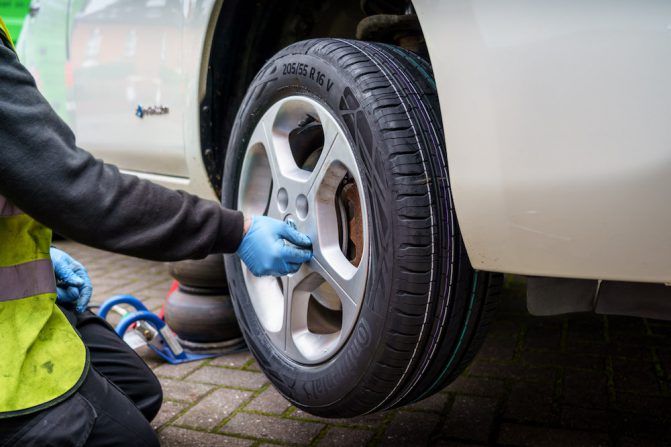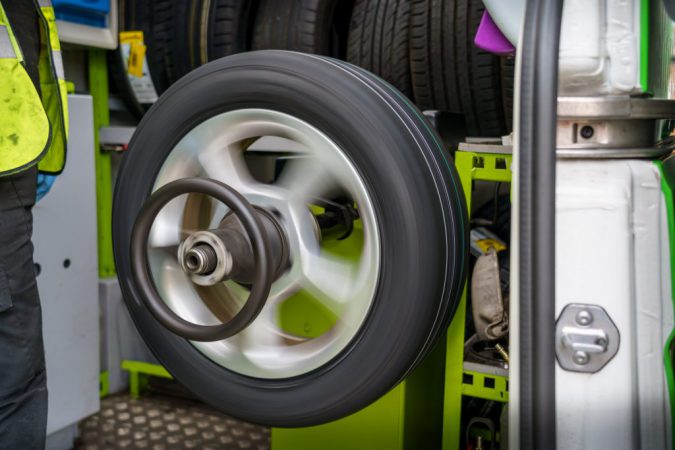The only part of your car that makes touch with the road is the tires. As a result, they are incredibly vital. To get from point A to point B safely, you’ll need them to be robust, durable, and of good quality. Your tires, on the other hand, will begin to wear out with time. Inside tire wear can substantially slow down your car, causing you to lose control of the steering wheel and endanger yourself.
You should replace your tires every 25,000 to 50,000 or so miles, depending on how much you drive. Snow, or variable temperatures, and the common occurrence of winter potholes all contribute to tire wear and tear. In reality, your car’s tires often have a tale to tell, and you’ll need to know what the tire wear patterns signify if you want to figure out how well they’re doing.
Why Are The Insides Of My Car Tires Wearing Out?
Driving a car on the road with insufficient tire tread is dangerous. You may lose control of your vehicle if your car tire is unable to grasp the road. If there were only one drop of rain between the tires and the road, the tire tread would have to cut through it to stay in contact with the surface. It causes the inside edge of your vehicle’s tires to wear out.
Let’s look at the most typical reasons for inside tire wear in more detail.
1. The Wheel Alignment Could Be Off
The term “wheel alignment” refers to the process of correcting the angles of the wheels to the specifications of the manufacturer. Tire wear should be uniformly distributed throughout the tire’s tread when the vehicle’s wheels are correctly aligned.
Inside tire wear might develop if the alignment is off. Without touching the steering wheel, the vehicle will automatically pull to the left or right of the road. To keep straight on your journey, you may find yourself frequently correcting the steering wheel.
If you see your vehicle dragging to one side of the road, you should have the wheel alignment re-calibrated right away since this will quickly wear down your tires. Driving in this state is also quite hazardous.
2. You Might Have Negative Camber
The camber angle of a tire is its angle with respect to a flat road beneath it. You have a negative camber angle if the bottoms of your tires are inclined outwards and the tops are angled inwards when viewed from the front of your car.
A traditional car can use a negative camber angle of 0.5 to 1° to retain optimal turning and braking grip with evenly distributed tire wear. A camber angle greater than this is not advised for a typical daily automobile. Don’t have to turn at 60 mph, and “regular” street vehicles aren’t built to handle extreme camber angles. You should not have any uneven tire wear if your camber is set according to the manufacturer’s specifications.
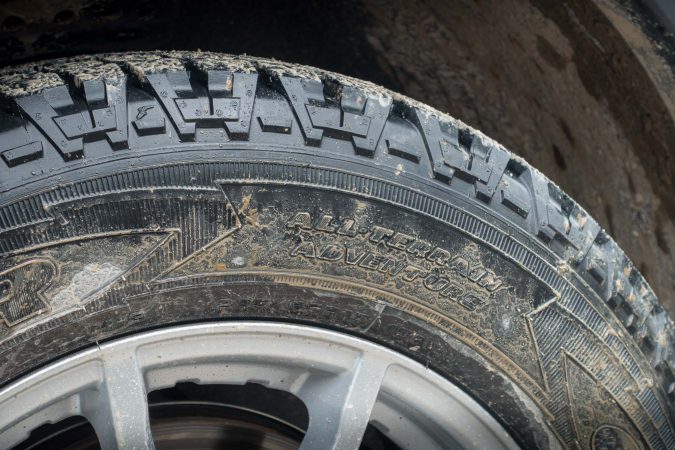
You may experience the following issues if you set your camber at too much of a negative angle:
- Your off-road driving abilities will be severely limited if not completely eliminated.
- Your brakes or steering may lock if your camber is too negative.
- Because less of your tire is in contact with the road, you’ll have less traction on straights and less control in the rain.
- If the angle is excessively steep, the inside tire wear will occur, and you’ll need to replace them more regularly.
- Increased wear and strain on the components that keep your wheels on could cause them to fall off.
These are some of the reasons why, in most circumstances, a street vehicle’s negative camber should not exceed 1 degree.
3. Your Ball Joints Are Wearing Out
The ball joints connect the control arms of your car to the steering knuckles, allowing you to drive the wheels in the direction you want while driving. Worn ball joints can be caused by inside tire wear. Your ball joints are worn down if you notice your vehicle turning to the left or right on its own when passing over bumps in the road. If your car loses control in this manner, you should have the ball joints checked to avert disaster.
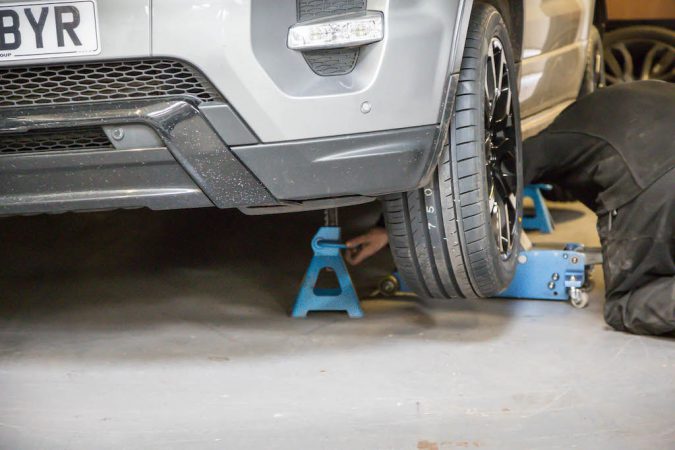
4. A Worn Out Wheel Bearing
A wheel bearing is a group of balls inside the wheel held together by a metal ring. Your tires may spin reliably with as little friction as possible due to wheel bearings. A faulty wheel bearing might cause inside tire wear. It might be a good time to find wheel bearing repair shops near me.
5. Tie Rod Ends Have Been Worn Out
A tie rod connects your car’s wheels to the suspension and steering components, allowing your vehicle to steer. Tie rods can be damaged by everyday use, uneven roads, or speed bumps. When tie rods wear out, they no longer hold your tires in the proper position, resulting in inside tire wear.
6. Faulty Control Arm Bushings
Control arms are the parts of your car that prohibit forward and backward movement by controlling your wheels’ upward and downward. Control arm bushings are the components that allow the control arms to move, and if they’re worn out, they might cause your tire to wear unevenly.
7. Shock Absorbers Or Worn Struts
Worn struts or shock absorbers are also responsible for causing inside tire wear. In this case, the vehicle wheels bounce significantly, particularly over uneven terrains, causing the tread to develop an inner or outerwear pattern. When you hit a speed bump, it also vibrates the steering wheel.
8. Damage Trailing Link Bushing
Trailing arm bushings connect your car’s pivot and axle point and form the vehicle’s trailing arm suspension. Front trailing arms are held onto the chassis by bushings attached to a bolt that runs through them. When trailing arm bushings are worn out, your suspension may become out of alignment, resulting in inside tire wear.
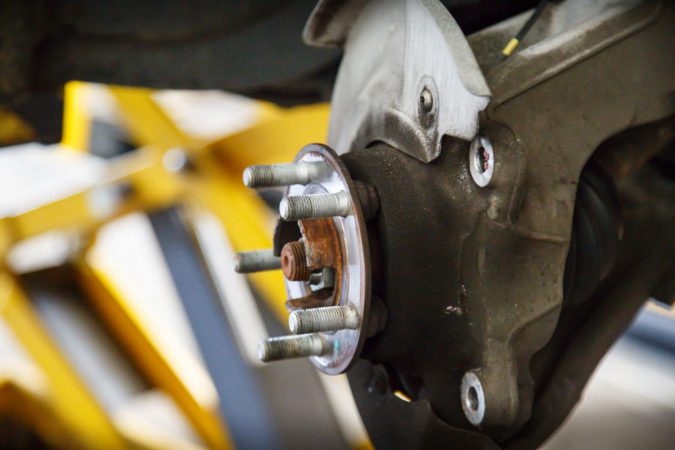
9. Tires That Are Underinflated
Underinflated tires will wear on the inner and outside of your tires, leaving a healthy tread strip in the middle. Check the manufacturer’s recommended tire pressure on a sticker inside your car’s door jab (as you would with the Tesla Model 3 tire pressure). To avoid punchers, blowouts, or loss of control, check the tire pressure regularly.
10. Toe Positioning
The front tires may point outward or inward if your vehicle’s toe settings are wrong, causing excessive inside tire wear. The reason for this is because the interior of your tires is subjected to increased forces. However, if your toe alignment is done correctly, your tires should face straight forward, not inward or outward, reversing and therefore not resulting in inside tire wear.
When Driving, How Do You Check Your Ball Joints?
When driving, you may easily check your ball joints by doing the following:
1. Go For A Drive In Your Car
Drive the vehicle on a public road at the legal speed limit while keeping a close eye on the engine, steering, and general performance. Next is to watch out for these things:
- Vibrations
As a ball joint wears out, it loosens up, causing a vibration that you can feel through the floor or steering wheel while driving. Wearing ball joints causes the steering wheel to pull from left to right on its own, causing it to stray to the left or right. This might also result in inside tire wear.
2. Drive Through Speed Bumps
Take it somewhere with speed bumps and drive it at a modest speed after driving at the speed limit. Stop and go, as well as turn a couple of times. Now look for the following thing:
- A clunking or squeaking sound can be heard
The worn ball joints rattling as the suspension goes up and down over the road causes clunking noises. The squeaking noise is generated when the rubber boot that protects the grease inside the ball joint is damaged. When the rubber boot is damaged, the ball joint begins to squeak. As the ball joints grow increasingly worn, these noises will become louder.
3. Take The Wheel And Turn It
The final step is to park the car and spin the wheels back and forth a few times while listening for ball joint noise.
How To Calculate Camber
Step 1: Connect the camber gauge to the spindle. The wheels should be pointed straight ahead. The gauge should then be connected to the wheel or spindle according to the tool’s specifications. If the gauge comes with a magnetic adaptor, ensure it’s attached to a flat surface square to the spindle.
Step 2: Adjust the gauge to its proper position. Rotate the gauge until the bubble at the end of the gauge indicates that it is on the level.
Step 3: Inspect the dial. Look at the two bubbles in the vials on either side of the gauge to read it. They are denoted by the letters + and -. The line indicates the camber reading in the center of each bubble. Each line represents a quarter turn. If you have a digital gauge, you can read the measurements from the display.
Ask a mechanic for assistance if you want to have the alignment checked by a professional rather than purchasing a costly tool to do the task yourself.
Is It Dangerous To Drive With Worn Tires?
Tires are one of the most ignored components of your vehicle, but they are also one of the most critical. Because worn tires have minimal tread or none at all, driving on them is highly unsafe. Tire tread is required for the tire to establish a grip on the road and offer you vehicle stability and control.
The majority of us don’t notice our tires until it’s too late. It is not necessary for an accident to occur when it is raining or snowing. It could be a beautiful day, and you’re driving down the highway when you find yourself in a situation where you need to apply the brakes right away. Your braking distance will dramatically increase if your tires are worn.
Tire Maintenance Tips To Avoid Inside Tire Wear
Examine Your Alignment
Check your alignment at least once a year, and always after hitting something hard with your front wheels, such as an open manhole or anything else that has significantly shocked the wheel system.
Maintain Correct Tire Air Pressure
Tires that are overinflated or underinflated will wear unevenly. While the door is open, look inside for a sticker with the manufacturer’s suggested tire pressure. This label can also be found inside the vehicle on the trunk lid, fuel flap, or console. For most passenger cars, the recommended pressure is between 30 and 35 PSI.
Rotate The Tires
Rotating your tires helps to balance out the wear on your tires’ tread. Front-wheel-drive vehicles’ tires are subjected to far more wear and tear than rear-wheel-drive vehicles tires. On average, we also take left turns a little faster than right turns. Rotating your tires will keep you from replacing your front tires before your back tires need to be replaced.
Examine Your Tires If They Are Balanced
Make sure your wheels are balanced properly. It will ensure a smooth ride and consistent tread wear on your tires.
Visually Check The Condition Of Your Tires
Visual inspections once a month are an excellent approach to keep your tires from wearing on the inside. Check if your tires are sitting at an angle when you park your car on flat ground, i.e., camber. Inspect the tires as well to observe how they wear.
Take Your Car To A Mechanic For Repairs
If you notice any inside tire wear, then it’s better to take it to a mechanic. This allows the mechanic to examine your suspension and determine what is wrong. The mechanic will search for any loose components or worn bushings in the control arms and trailing arms.
How To Inspect Your Tires For Inside Tire Wear
The 20p test is the quickest and easiest way to check your tire wear. Take a 20p coin and insert it into one of your tire’s main grooves. It could be easier to start the engine and turn the steering wheel. If you’re examining the right tire, simply turn the wheel to the left and vice versa.
A border surrounds each 20p coin. Once you’ve inserted the coin into the groove, make sure you can’t see the entire coin’s border. This indicates that the tread depth is adequate, which is a good thing. If the coin’s border is apparent, your tires are likely to be worn out and maybe below the permissible limits.
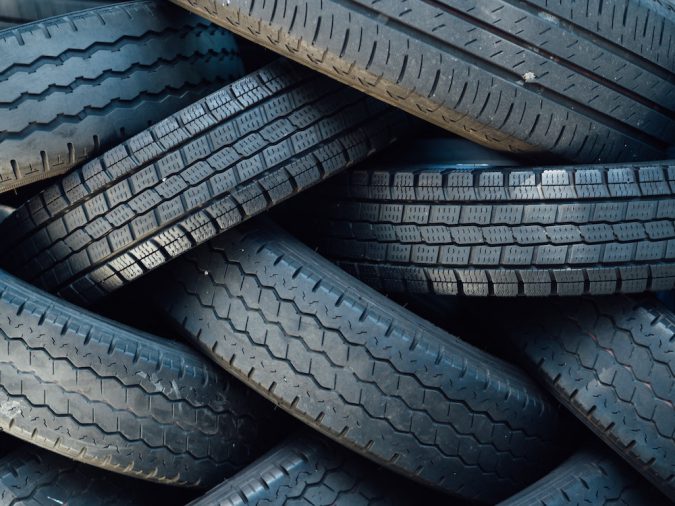
Don’t only test one spot on the tire when performing this test. As previously stated, depending on pressure or wheel alignment, your tires may wear unevenly. Check each tire in at least three separate locations. If your tires are worn down in any of the spots you checked, you should take them to a repair.
Do Low-Cost Tires Wear Out Faster?
Cheaper tires may be preferable for persons who drive less and at slower speeds. You may travel more in the city than on highways or dual carriageways. They do, however, wear out faster than premium tires.
What Causes A Car’s Wheel Alignment To Change?
Unfortunately, proper wheel alignment does not endure very long. You could get your wheel alignment and then hit a pothole or a curb right after leaving the auto repair shop, causing a drastic shift in your wheel alignment.
Even if you don’t notice a sudden change in your wheel alignment, it is altering all the time. In 12 to 18 months, a significant shift in alignment might occur. It’s easy for handling faults and tire wear conditions to become firmly established if it takes 12 to 18 months to experience concerns with the wheel alignment.
The joints and bushings in the suspension system that are responsible for accurate alignment wear down with time, making it more challenging to maintain the alignment. Camber and caster start to shift. In addition, over time, the steering mechanism wears out, and the wheel alignment shifts. The rear wheel alignment suffers from the same problem.
The alignment begins to move slowly when the rear suspensions start to degrade. Even though this is a simple procedure, you may need to repair some suspension system components before the alignment can be completed. You may notice sudden changes in wheel alignment, which are usually produced by impact or collision, in contrast to the gradual wear.
Before you can fix the wheel alignment, you’ll need to replace the broken components.
If you’re having problems with your wheel alignment, schedule an appointment with an auto repair shop to have it fixed.
How To Align Your Wheels And Prevent Inside Tire Wear?
If your tires are wearing away in one location, but you don’t think it’s due to under-or overinflation, your wheel alignment may be off. The angle at which your tires are positioned is referred to as wheel alignment or tracking. To ensure that your steering is precise, you want them to be perfectly straight. However, the tires can occasionally lean in one direction or the other.
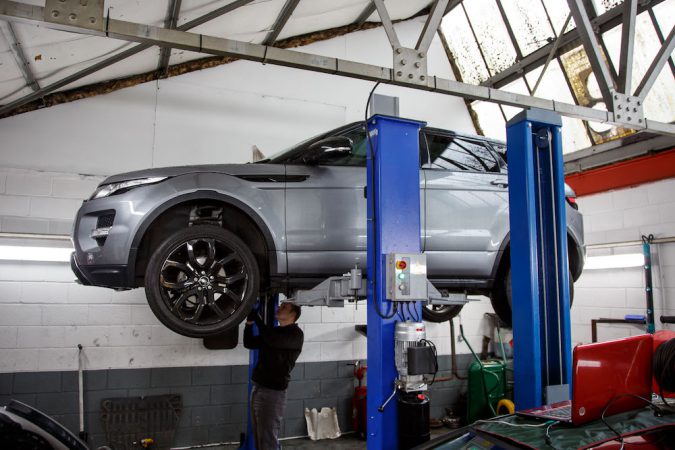
If you’ve observed that your vehicle leans to one side or that your steering wheel rattles, it’s possible that you have an alignment issue. To begin, examine the condition of your tires. Is there wear only on the inside edge of the tire and not elsewhere? Is there any wear on the exterior of the tire, on the other hand?
Your tires may be ‘towed’ if you responded yes to either of these questions. A towed tire will lean slightly to the right or left so that the car’s whole weight is distributed to the side rather than the flat part of the tire.
You can take it to a garage where a laser alignment tool is available. A mechanic will identify if one or more of the wheels are misaligned with this tool. Correct wheel alignment might extend the life of your tires by up to 12,000 miles, so make sure they’re completely straight.
Inner Tire Wear: How To Fix It
The Following are Some Methods for Repairing Inside Tire Wear:
- Aligning the wheels
- It is necessary to inflate the tire properly.
- Wheel balancing on a regular basis
- Suspension components that have been damaged should be repaired or replaced
- Tire tread depth should be checked regularly.
1. Alignment Of The Wheels
Wheel alignment is a crucial step in extending the life of your tires. It is critical that you have your wheels aligned to eliminate camber angle issues, worn ball joints, and other issues that could damage your springs. After around 5,000 miles or at least once every two years, take your vehicle in for a wheel balance and checkup.
2. Inflation Of Tires Properly
Inside tire wear is caused by the sidewall’s failure to force the tires to make proper contact with the road when they are underinflated or overinflated. Make an effort to check tire pressures and pump them regularly. To avoid rapid inside tire wear, deflate the tires if they are overinflated.
3. Wheel Balancing On A Regular Basis
Mechanics claim that the average vehicle owner only brings their car in for a tire examination after noticing wear. Keep in touch with your mechanic on a regular basis, and have your wheels balanced at least once every two years. It’s also a good idea to have new tires balanced after they’ve been installed on your car. This will prevent it from premature wear.
4. Repair Or Replace Damaged Suspension Components
Damaged suspension components cause the inside tire wear faster. It can also reduce vehicle speed, resulting in increased gas consumption. It’s worth noting that failing to repair damaged suspension components leads to irreversible damage.
5. Examine The Depth Of The Tread On Your Tires Regularly
Evaluate the tread depth of your tires regularly. The manufacturer’s tread depth on new tires is good; however, the thread thins over time. Check to see whether your tires have less than the required tread depth.
Inner Tire Wear and How to Fix It
- Tire position inconsistency and misalignment can cause your tires to wear unevenly and become obsolete faster than usual.
- Fixing inner tire wear requires performing a wheel alignment, properly inflating tires, balancing wheels, inspecting and replacing damaged suspension components, and checking the tire tread depth.
- Rotate your tires every six months after fixing inner tire wear to extend their lifespan.
- It’s always best to have a professional check on your tires before investing in a new set of rubber.
- Negative camber, worn ball joints, misaligned wheels, toe settings, worn tie rods, improperly inflated tires, and faulty shocks and struts can cause inner tire wear.
- Negative camber is the most common cause of inner tire wear, causing the inner tire to wear out faster because the entire weight of the car is placed mostly on the inner edge of the tire.
- Worn ball joints can cause inner tire wear, and they are not designed to last forever.
- Improper wheel alignment, toe settings, and worn tie rods can also cause uneven tire wear.
- Improperly inflated tires and faulty shocks and struts can distort the shape of your tire, causing certain areas of the tire to wear faster.
- The minimum legal tread depth is 2/32 of an inch, and inner tire wear can cost anywhere from $60 to over $2,000 to fix, depending on the cause.
Final Verdict On Inside Tire Wear:
Tires are becoming more expensive every year, and taking appropriate care of them can help preserve their important tread. Tires are the most vital parts of your vehicle to maintain and replace when necessary because they connect our cars to the road. You can have the safest car, but you will crash if your inside tire wear down and blows out on the highway.
A variety of factors can cause inside tire wear. It’s possible that your wheels have been misaligned for a long time, the camber angle is incorrect, ball bearings and joints are worn out, or one of the suspension components is broken.
Check your tire tread at least once a week to make sure it isn’t wearing down unevenly, as this always signals that something is wrong with the car. Don’t just replace the tire, address the underlying issue as well.

